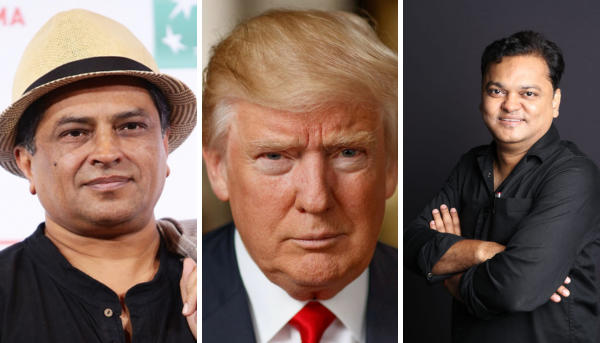
In a bold move that has sent ripples across global film industries, U.S. President Donald Trump has announced a plan to impose a 100 percent tariff on any film produced outside the United States and imported into the country. The announcement—made via his preferred social platform—claims that the American movie business has been “stolen” by foreign filmmaking and insists the new measure is meant to reclaim control over the domestic entertainment market.
The declaration has sparked unease and debate worldwide, particularly in India, where cinema exports and collaborations constitute a significant facet of the industry. For Indian filmmakers like Pan Nalin and Amit Rai, this proposed change represents more than just a trade barrier — it strikes at the heart of art, audience access, and the very idea of cross-border storytelling.
The Trump Move: What Was Announced
Trump posted that he will impose a 100% tariff on all movies made outside the United States and also hinted at “substantial tariffs” on furniture and other goods not manufactured domestically. He framed the change as part of a broader push to bring movie production back home, suggesting that foreign countries are luring talent away with incentives and undermining U.S. dominance.
However, the announcement is vague in its practical outlines: How would such a tariff even be enforced in an era when most films cross borders digitally? Would post-production services or special effects done overseas be included? And how would the tariff apply to films shot partly abroad or in multinational co-productions? Legal and logistical experts have already flagged numerous ambiguities.
Reactions from Indian Filmmakers: Pan Nalin and Amit Rai Speak Out
Pan Nalin: “This Theft Narrative Doesn’t Hold”
National Award–winning filmmaker Pan Nalin pushed back firmly against Trump’s rhetoric. He rejected the claim that the U.S. film business was “taken,” pointing out that the American industry is currently enjoying unparalleled robustness. Citing recent earnings, he emphasized that Hollywood studios are thriving, not under threat.
Nalin also downplayed the direct impact on Indian films. He noted that only a small fraction (roughly 2–4 percent) of Indian productions see a theatrical release in the U.S. — primarily big-star vehicles aimed at diaspora audiences. He warned that ticket prices might spike (for example, from the range of USD 8–10 to USD 16–20), but said that beyond communities of Indian origin, Indian movies do not command wide viewership in America.
Amit Rai: “Cinema Can’t Be Shrunk to Borders”
Director Amit Rai, known for films like OMG 2, described the proposed tariff as “impractical” and warned that protectionist strategies of this kind pose existential risks to the global cultural order. He argued that stories, by nature, require room to breathe — to cross languages and geographies.
Rai cautioned that if every nation adopted such inward-looking stances — in the name of “making one’s own country great” — the entire ecosystem of art and exchange could collapse. “Cinema doesn’t see borders or flags,” he said, urging a rethink of the policy before it causes irreparable damage.
Industry Observers and Trade Bodies Weigh In
Shibasish Sarkar, President of the Producers Guild of India, suggested that Trump’s target might be Hollywood more than Indian or foreign-language films. He speculated that the tariff is intended to bring back large-scale U.S. studio productions that have increasingly relocated to places like Canada, Spain, or South Korea for tax breaks. But without seeing the detailed executive orders, Sarkar said, it’s difficult to interpret Trump’s intention with certainty.
Meanwhile, exhibitors and trade insiders cautioned that much will depend on the fine print. As one cinema-chain executive noted, Trump’s announcements often come first on social media, with clarifications following later. If applied rigidly, a 100 percent film tariff could drastically raise costs and shift audiences toward streaming models, especially for Indian films in the U.S.



